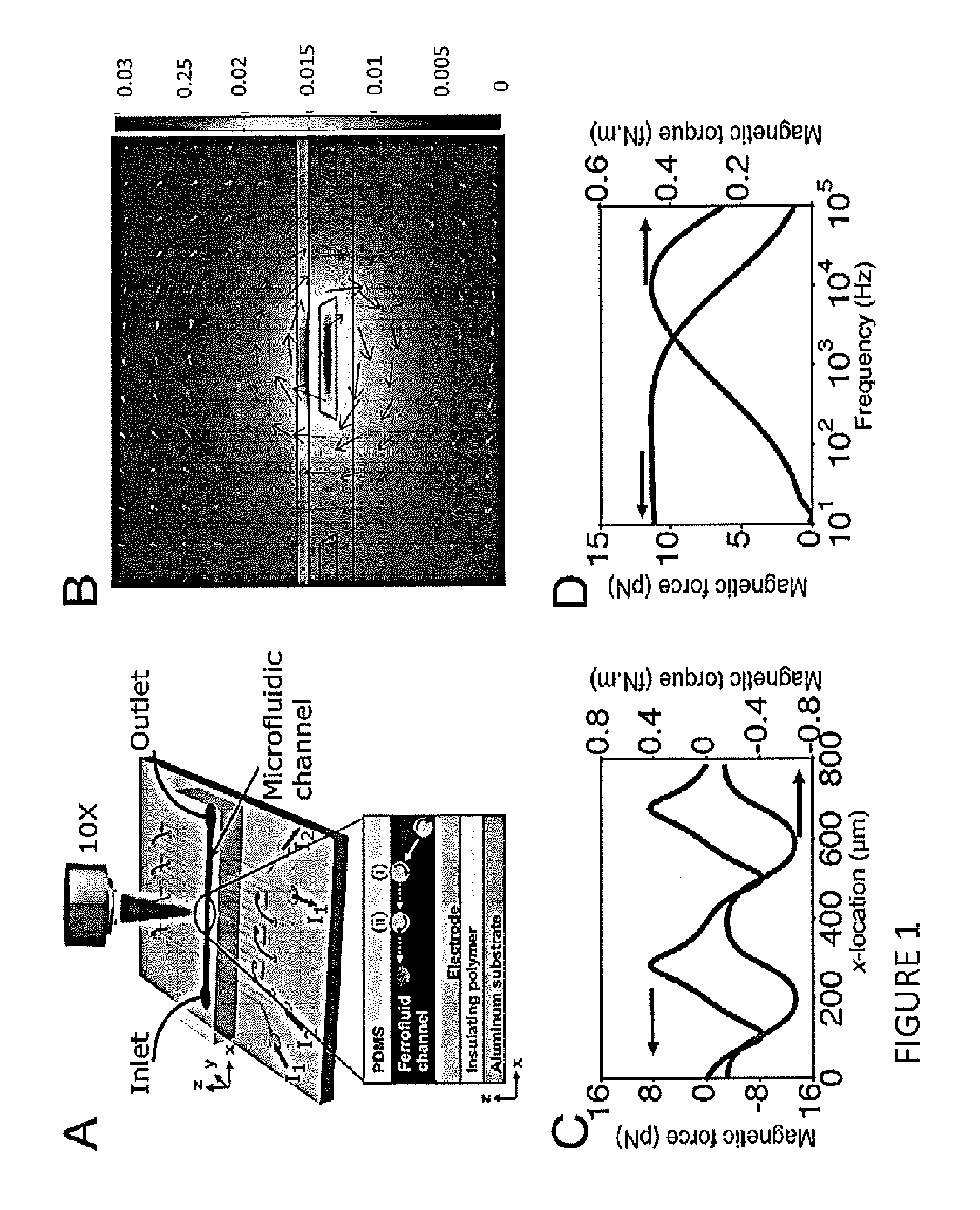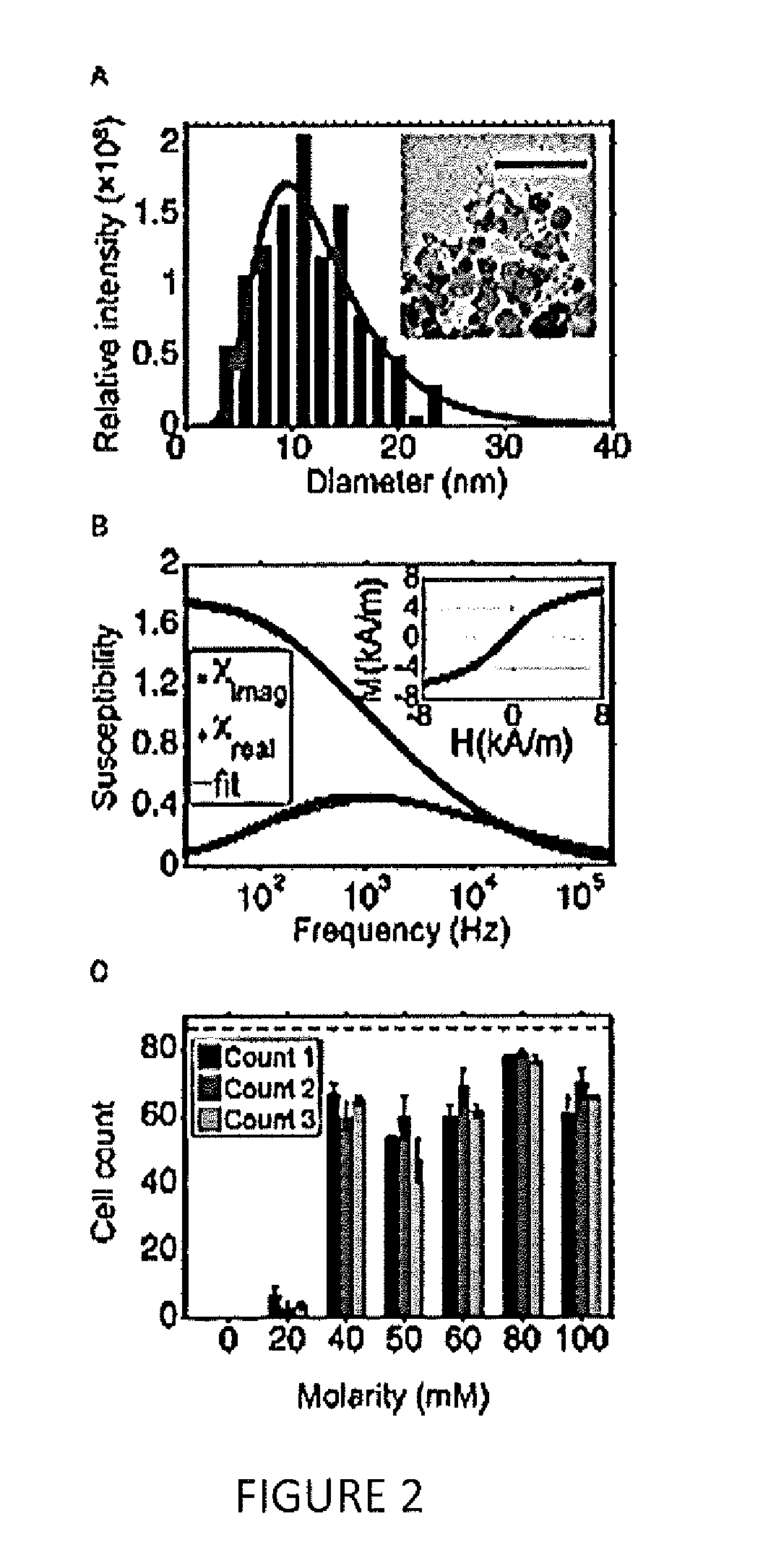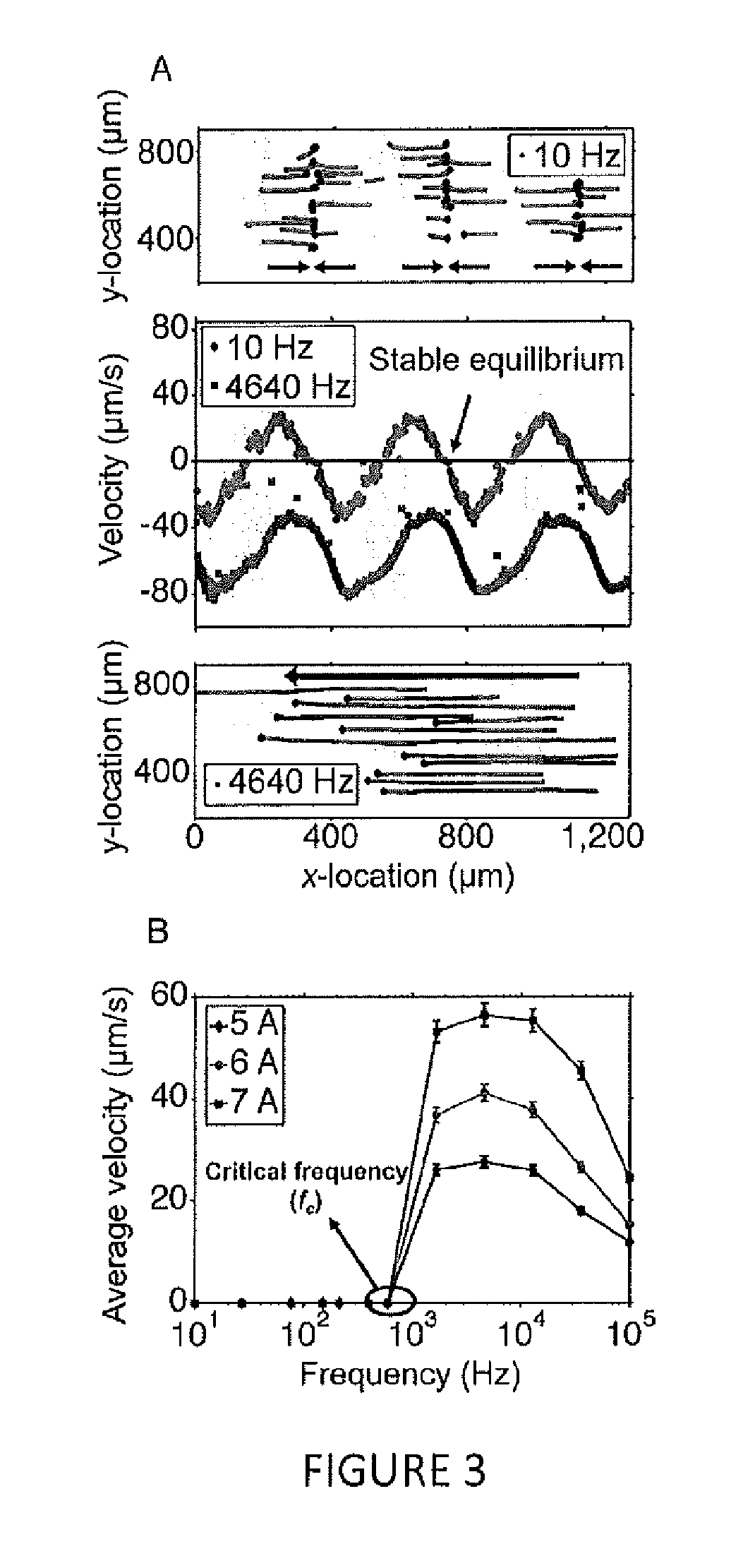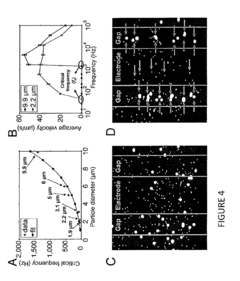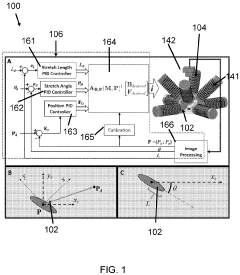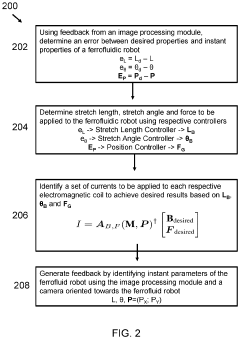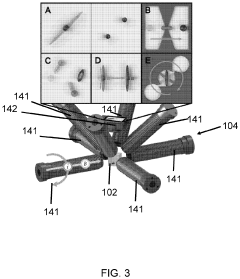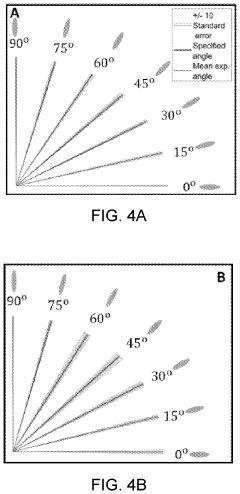How to Optimize Ferrofluid for Applications in Robotics?
JUL 9, 20259 MIN READ
Generate Your Research Report Instantly with AI Agent
Patsnap Eureka helps you evaluate technical feasibility & market potential.
Ferrofluid in Robotics: Background and Objectives
Ferrofluids, a unique class of magnetic nanomaterials, have garnered significant attention in the field of robotics due to their remarkable properties and potential applications. These colloidal suspensions of magnetic nanoparticles in a carrier fluid exhibit both liquid and magnetic characteristics, making them particularly intriguing for robotic systems. The development of ferrofluids can be traced back to the 1960s when NASA scientists sought to create a magnetic liquid for controlling fluids in space.
Over the past few decades, ferrofluids have evolved from a niche scientific curiosity to a versatile material with diverse applications across various industries. In the context of robotics, ferrofluids offer exciting possibilities for enhancing the capabilities and performance of robotic systems. The unique ability of ferrofluids to change shape and properties in response to magnetic fields presents opportunities for developing novel actuators, sensors, and adaptive structures in robotics.
The primary objective of optimizing ferrofluids for robotic applications is to harness their distinctive properties to overcome existing limitations in robotic systems and enable new functionalities. This includes improving the precision and responsiveness of robotic movements, developing more efficient and compact actuators, and creating adaptive interfaces between robotic components and their environment.
One of the key technological trends driving the optimization of ferrofluids in robotics is the push towards miniaturization and increased flexibility in robotic systems. As robots become smaller and more versatile, there is a growing need for materials and components that can provide complex functionalities within compact form factors. Ferrofluids, with their ability to be precisely controlled and manipulated at small scales, align well with this trend.
Another significant trend is the development of soft robotics, where flexible and compliant materials are used to create robots that can interact more safely and adaptively with their environment. Ferrofluids, with their fluid nature and controllable properties, offer potential solutions for creating soft actuators and adaptive structures in these next-generation robotic systems.
The optimization of ferrofluids for robotic applications aims to address several key challenges. These include improving the stability and longevity of ferrofluids in dynamic robotic environments, enhancing their responsiveness to magnetic fields for faster and more precise control, and developing methods to integrate ferrofluids seamlessly into existing robotic architectures.
As research in this field progresses, the goal is to unlock the full potential of ferrofluids in robotics, potentially revolutionizing areas such as medical robotics, industrial automation, and space exploration. By optimizing ferrofluids for specific robotic applications, researchers and engineers aim to create more efficient, adaptable, and capable robotic systems that can tackle complex tasks in diverse environments.
Over the past few decades, ferrofluids have evolved from a niche scientific curiosity to a versatile material with diverse applications across various industries. In the context of robotics, ferrofluids offer exciting possibilities for enhancing the capabilities and performance of robotic systems. The unique ability of ferrofluids to change shape and properties in response to magnetic fields presents opportunities for developing novel actuators, sensors, and adaptive structures in robotics.
The primary objective of optimizing ferrofluids for robotic applications is to harness their distinctive properties to overcome existing limitations in robotic systems and enable new functionalities. This includes improving the precision and responsiveness of robotic movements, developing more efficient and compact actuators, and creating adaptive interfaces between robotic components and their environment.
One of the key technological trends driving the optimization of ferrofluids in robotics is the push towards miniaturization and increased flexibility in robotic systems. As robots become smaller and more versatile, there is a growing need for materials and components that can provide complex functionalities within compact form factors. Ferrofluids, with their ability to be precisely controlled and manipulated at small scales, align well with this trend.
Another significant trend is the development of soft robotics, where flexible and compliant materials are used to create robots that can interact more safely and adaptively with their environment. Ferrofluids, with their fluid nature and controllable properties, offer potential solutions for creating soft actuators and adaptive structures in these next-generation robotic systems.
The optimization of ferrofluids for robotic applications aims to address several key challenges. These include improving the stability and longevity of ferrofluids in dynamic robotic environments, enhancing their responsiveness to magnetic fields for faster and more precise control, and developing methods to integrate ferrofluids seamlessly into existing robotic architectures.
As research in this field progresses, the goal is to unlock the full potential of ferrofluids in robotics, potentially revolutionizing areas such as medical robotics, industrial automation, and space exploration. By optimizing ferrofluids for specific robotic applications, researchers and engineers aim to create more efficient, adaptable, and capable robotic systems that can tackle complex tasks in diverse environments.
Market Analysis for Ferrofluid-Based Robotic Applications
The market for ferrofluid-based robotic applications is experiencing significant growth, driven by advancements in robotics technology and the unique properties of ferrofluids. Ferrofluids, which are magnetic liquids composed of nanoscale ferromagnetic particles suspended in a carrier fluid, offer a range of potential applications in robotics, including actuators, sensors, and adaptive structures.
The global robotics market is projected to reach $260 billion by 2030, with a compound annual growth rate (CAGR) of 17.45% from 2023 to 2030. Within this broader market, the demand for ferrofluid-based solutions is expected to grow rapidly, particularly in sectors such as healthcare, manufacturing, and aerospace.
In the healthcare sector, ferrofluid-based robotic applications show promise in targeted drug delivery systems, minimally invasive surgical procedures, and advanced prosthetics. The precision and controllability offered by ferrofluids align well with the increasing demand for more accurate and less invasive medical interventions.
The manufacturing industry is another key market for ferrofluid-based robotic applications. As factories move towards more flexible and adaptive production systems, ferrofluid actuators and sensors can provide the necessary responsiveness and precision. This is particularly relevant in industries requiring high-precision assembly, such as electronics and automotive manufacturing.
Aerospace and defense sectors are also showing interest in ferrofluid-based robotic applications. The ability of ferrofluids to respond to magnetic fields without mechanical parts makes them attractive for use in adaptive structures, vibration damping systems, and advanced control mechanisms in aerospace applications.
The market for ferrofluid-based robotic applications is characterized by a high degree of innovation and research activity. Several startups and research institutions are actively developing new applications and improving existing technologies. This innovation pipeline suggests a strong potential for market expansion in the coming years.
However, challenges remain in terms of scalability and long-term stability of ferrofluid-based systems. Addressing these challenges will be crucial for wider market adoption. Additionally, the relatively high cost of ferrofluids and the need for specialized knowledge in their application may initially limit market penetration to high-value, performance-critical applications.
Despite these challenges, the market outlook for ferrofluid-based robotic applications remains positive. As research progresses and manufacturing processes improve, we can expect to see a broader range of applications and increased market penetration across various industries.
The global robotics market is projected to reach $260 billion by 2030, with a compound annual growth rate (CAGR) of 17.45% from 2023 to 2030. Within this broader market, the demand for ferrofluid-based solutions is expected to grow rapidly, particularly in sectors such as healthcare, manufacturing, and aerospace.
In the healthcare sector, ferrofluid-based robotic applications show promise in targeted drug delivery systems, minimally invasive surgical procedures, and advanced prosthetics. The precision and controllability offered by ferrofluids align well with the increasing demand for more accurate and less invasive medical interventions.
The manufacturing industry is another key market for ferrofluid-based robotic applications. As factories move towards more flexible and adaptive production systems, ferrofluid actuators and sensors can provide the necessary responsiveness and precision. This is particularly relevant in industries requiring high-precision assembly, such as electronics and automotive manufacturing.
Aerospace and defense sectors are also showing interest in ferrofluid-based robotic applications. The ability of ferrofluids to respond to magnetic fields without mechanical parts makes them attractive for use in adaptive structures, vibration damping systems, and advanced control mechanisms in aerospace applications.
The market for ferrofluid-based robotic applications is characterized by a high degree of innovation and research activity. Several startups and research institutions are actively developing new applications and improving existing technologies. This innovation pipeline suggests a strong potential for market expansion in the coming years.
However, challenges remain in terms of scalability and long-term stability of ferrofluid-based systems. Addressing these challenges will be crucial for wider market adoption. Additionally, the relatively high cost of ferrofluids and the need for specialized knowledge in their application may initially limit market penetration to high-value, performance-critical applications.
Despite these challenges, the market outlook for ferrofluid-based robotic applications remains positive. As research progresses and manufacturing processes improve, we can expect to see a broader range of applications and increased market penetration across various industries.
Current Challenges in Ferrofluid Optimization for Robotics
The optimization of ferrofluid for robotics applications faces several significant challenges that hinder its widespread adoption and effectiveness. One of the primary obstacles is the stability of ferrofluids in dynamic environments. Robotic systems often operate in conditions with varying temperatures, pressures, and electromagnetic fields, which can affect the colloidal stability of ferrofluids. Maintaining consistent properties and preventing particle agglomeration or sedimentation over extended periods remains a critical challenge.
Another major hurdle is the precise control of ferrofluid behavior in response to external magnetic fields. While ferrofluids can be manipulated using magnets, achieving fine-tuned control for complex robotic movements and interactions requires advanced magnetic field generation and control systems. The development of such systems that are compact, energy-efficient, and capable of rapid response times is an ongoing challenge in the field.
The viscosity of ferrofluids presents a dual challenge. On one hand, low viscosity is desirable for applications requiring rapid flow and minimal energy loss. On the other hand, higher viscosity can provide better damping and stability in certain robotic components. Striking the right balance and developing ferrofluids with tunable viscosity properties is a key area of research and development.
Compatibility with robotic materials and components is another significant concern. Ferrofluids must be chemically inert and non-corrosive to prevent degradation of robotic parts. Additionally, ensuring that ferrofluids do not interfere with electronic components or sensors in robotic systems is crucial for their successful integration.
The thermal management of ferrofluids in robotic applications poses another challenge. As robots operate, they generate heat, which can affect the properties of ferrofluids. Developing ferrofluids that maintain their magnetic and rheological properties across a wide temperature range is essential for reliable performance in diverse robotic applications.
Scaling up the production of high-quality ferrofluids for industrial robotic applications remains a challenge. Ensuring consistency in particle size, distribution, and magnetic properties across large batches is critical for the widespread adoption of ferrofluid-based technologies in robotics.
Lastly, the environmental impact and safety considerations of ferrofluids in robotics applications need to be addressed. Developing eco-friendly formulations and establishing protocols for the safe handling and disposal of ferrofluids are important challenges that need to be overcome for their sustainable use in robotics.
Another major hurdle is the precise control of ferrofluid behavior in response to external magnetic fields. While ferrofluids can be manipulated using magnets, achieving fine-tuned control for complex robotic movements and interactions requires advanced magnetic field generation and control systems. The development of such systems that are compact, energy-efficient, and capable of rapid response times is an ongoing challenge in the field.
The viscosity of ferrofluids presents a dual challenge. On one hand, low viscosity is desirable for applications requiring rapid flow and minimal energy loss. On the other hand, higher viscosity can provide better damping and stability in certain robotic components. Striking the right balance and developing ferrofluids with tunable viscosity properties is a key area of research and development.
Compatibility with robotic materials and components is another significant concern. Ferrofluids must be chemically inert and non-corrosive to prevent degradation of robotic parts. Additionally, ensuring that ferrofluids do not interfere with electronic components or sensors in robotic systems is crucial for their successful integration.
The thermal management of ferrofluids in robotic applications poses another challenge. As robots operate, they generate heat, which can affect the properties of ferrofluids. Developing ferrofluids that maintain their magnetic and rheological properties across a wide temperature range is essential for reliable performance in diverse robotic applications.
Scaling up the production of high-quality ferrofluids for industrial robotic applications remains a challenge. Ensuring consistency in particle size, distribution, and magnetic properties across large batches is critical for the widespread adoption of ferrofluid-based technologies in robotics.
Lastly, the environmental impact and safety considerations of ferrofluids in robotics applications need to be addressed. Developing eco-friendly formulations and establishing protocols for the safe handling and disposal of ferrofluids are important challenges that need to be overcome for their sustainable use in robotics.
Existing Ferrofluid Optimization Techniques for Robotics
01 Composition and preparation of ferrofluids
Ferrofluids are colloidal suspensions of magnetic nanoparticles in a carrier fluid. They are typically composed of magnetite or other ferromagnetic materials coated with a surfactant to prevent agglomeration. The preparation process involves careful control of particle size and distribution to maintain stability and magnetic properties.- Composition and preparation of ferrofluids: Ferrofluids are colloidal suspensions of magnetic nanoparticles in a carrier fluid. They are typically composed of magnetite or other ferromagnetic materials coated with surfactants to prevent agglomeration. The preparation process involves careful control of particle size and distribution to maintain stability and magnetic properties.
- Applications in sealing and lubrication: Ferrofluids are widely used in sealing and lubrication applications, particularly in rotating shaft seals. They provide a liquid barrier that can be controlled by magnetic fields, offering advantages in terms of low friction, long life, and the ability to operate in vacuum environments.
- Thermal management and cooling systems: Ferrofluids are employed in thermal management solutions, particularly for electronic devices. Their unique properties allow for efficient heat transfer and cooling when subjected to magnetic fields, making them valuable in applications such as computer cooling systems and power electronics.
- Damping and vibration control: The viscoelastic properties of ferrofluids make them useful in damping applications. They can be used to control vibrations in mechanical systems, providing adaptive damping that can be tuned by adjusting the applied magnetic field strength.
- Sensing and measurement applications: Ferrofluids are utilized in various sensing and measurement devices. Their response to magnetic fields and ability to change shape or position makes them suitable for applications such as accelerometers, inclinometers, and pressure sensors. They can also be used in magnetic field visualization and educational demonstrations.
02 Applications in sealing and lubrication
Ferrofluids are widely used in sealing and lubrication applications, particularly in rotating shaft seals. They provide a liquid barrier that can be controlled by magnetic fields, offering advantages in terms of low friction, long life, and the ability to operate in vacuum environments.Expand Specific Solutions03 Thermal management and cooling systems
Ferrofluids are employed in thermal management solutions, particularly for electronic devices. Their unique properties allow for efficient heat transfer and cooling when subjected to magnetic fields, making them valuable in applications such as computer cooling systems and power electronics.Expand Specific Solutions04 Damping and vibration control
The viscoelastic properties of ferrofluids make them useful in damping applications. They can be used to control vibrations in mechanical systems, providing adaptive damping that can be tuned by adjusting the applied magnetic field strength.Expand Specific Solutions05 Sensing and measurement applications
Ferrofluids are utilized in various sensing and measurement devices. Their response to magnetic fields and ability to change shape or position makes them suitable for applications such as accelerometers, inclinometers, and pressure sensors. They can also be used in magnetic field visualization and measurement tools.Expand Specific Solutions
Key Players in Ferrofluid and Robotics Industries
The optimization of ferrofluid for robotics applications is in an early development stage, with a growing market potential as robotics technology advances. The market size is expanding, driven by increasing demand for precise and adaptive robotic systems. Technologically, ferrofluid optimization is still evolving, with varying levels of maturity among key players. Universities like Yale, Arizona State, and Delft University of Technology are conducting fundamental research, while companies such as Ferrotec and LORD Corporation are developing practical applications. The involvement of diverse institutions, from academic to industrial, indicates a competitive landscape with opportunities for innovation and commercialization in this emerging field.
Delft University of Technology
Technical Solution: Researchers at Delft University of Technology have made significant advancements in optimizing ferrofluids for robotic applications. Their approach focuses on developing magnetically-controlled soft robots using ferrofluids as actuators. By carefully tuning the magnetic properties and rheological behavior of ferrofluids, they have created systems capable of precise, controllable deformations[1]. The team has also explored the use of multi-component ferrofluids, combining different types of magnetic nanoparticles to achieve enhanced responsiveness and stability[2]. Additionally, they have developed novel microfluidic techniques for ferrofluid synthesis, allowing for greater control over particle size distribution and magnetic properties[3]. This has resulted in ferrofluids with improved uniformity and performance consistency, crucial for reliable robotic operations.
Strengths: Cutting-edge research in ferrofluid-based soft robotics, innovative synthesis techniques, and focus on practical applications. Weaknesses: Research may be at earlier stages of development compared to commercial solutions, potential challenges in scaling up production.
LORD Corp.
Technical Solution: LORD Corporation has developed advanced magnetorheological (MR) fluids, a type of smart fluid related to ferrofluids, optimized for robotics and control systems. Their approach focuses on creating highly responsive fluids that can rapidly change their rheological properties under applied magnetic fields. LORD's MR fluids are designed to provide precise, controllable damping and resistance in robotic joints and actuators[1]. The company has also worked on improving the durability and temperature stability of their fluids, ensuring consistent performance in diverse robotic applications[2]. Additionally, LORD has developed integrated sensor and control systems that work in conjunction with their smart fluids, allowing for real-time adjustment of fluid properties based on robotic system demands[3]. This holistic approach enables more adaptive and efficient robotic movement and control.
Strengths: Extensive experience in smart fluid technology, integrated solutions combining fluids and control systems, proven track record in industrial applications. Weaknesses: Primary focus on MR fluids rather than traditional ferrofluids, may require adaptation for some ferrofluid-specific applications.
Innovative Approaches in Ferrofluid-Robotic Integration
Label-free cellular manipulation and sorting via biocompatible ferrofluids
PatentActiveUS20120237997A1
Innovation
- A microfluidic platform using biocompatible ferrofluids with a microfluidic channel and electrodes that generate a magnetic field pattern, allowing for the controlled manipulation and separation of microparticles and live cells based on size, shape, and elasticity, with high efficiency and rapid separation capabilities.
Systems and methods for controlling shape and position of a ferrofluid droplet
PatentActiveUS20220265379A1
Innovation
- A system comprising a ferrofluid droplet and an electromagnetic field generation system with a controller that determines and applies necessary magnetic field parameters to control the position and shape of the ferrofluid droplet, using PID controllers to adjust electric currents in electromagnetic coils to manipulate the ferrofluid's position, stretch angle, and stretch length.
Environmental Impact of Ferrofluid Use in Robotics
The environmental impact of ferrofluid use in robotics is a critical consideration as this technology gains traction in various applications. Ferrofluids, composed of nanoscale ferromagnetic particles suspended in a carrier fluid, offer unique properties that enhance robotic capabilities. However, their widespread adoption raises concerns about potential ecological consequences.
One primary environmental concern is the potential release of nanoparticles into ecosystems. If ferrofluids leak or are improperly disposed of, these particles could contaminate soil and water systems. The small size of nanoparticles allows them to penetrate biological barriers, potentially affecting organisms at various trophic levels. Studies have shown that some nanoparticles can accumulate in aquatic organisms, leading to bioaccumulation in food chains.
The production process of ferrofluids also warrants attention. The synthesis of nanoparticles often involves energy-intensive processes and the use of potentially harmful chemicals. Scaling up production to meet growing demand in robotics could lead to increased industrial emissions and chemical waste, contributing to air and water pollution if not properly managed.
Recycling and disposal of ferrofluid-containing robotic components present another challenge. As robots reach end-of-life, proper handling of ferrofluid materials is crucial to prevent environmental contamination. Current recycling infrastructure may not be adequately equipped to handle these specialized materials, potentially leading to improper disposal in landfills.
On the positive side, the use of ferrofluids in robotics could indirectly benefit the environment. Robots enhanced with ferrofluid technology may operate more efficiently, reducing energy consumption and extending battery life. This could lead to decreased electronic waste and lower overall energy demands, aligning with sustainability goals.
To mitigate environmental risks, research into biodegradable ferrofluids and eco-friendly production methods is essential. Developing ferrofluids with non-toxic, naturally occurring magnetic particles could reduce potential harm to ecosystems. Additionally, implementing closed-loop systems in robotic applications could minimize the risk of ferrofluid release into the environment.
As the field advances, comprehensive life cycle assessments of ferrofluid-enhanced robots will be crucial. These studies should evaluate environmental impacts from production to disposal, informing design decisions and regulatory frameworks. Balancing the technological benefits of ferrofluids with environmental stewardship will be key to ensuring sustainable integration of this technology in robotics.
One primary environmental concern is the potential release of nanoparticles into ecosystems. If ferrofluids leak or are improperly disposed of, these particles could contaminate soil and water systems. The small size of nanoparticles allows them to penetrate biological barriers, potentially affecting organisms at various trophic levels. Studies have shown that some nanoparticles can accumulate in aquatic organisms, leading to bioaccumulation in food chains.
The production process of ferrofluids also warrants attention. The synthesis of nanoparticles often involves energy-intensive processes and the use of potentially harmful chemicals. Scaling up production to meet growing demand in robotics could lead to increased industrial emissions and chemical waste, contributing to air and water pollution if not properly managed.
Recycling and disposal of ferrofluid-containing robotic components present another challenge. As robots reach end-of-life, proper handling of ferrofluid materials is crucial to prevent environmental contamination. Current recycling infrastructure may not be adequately equipped to handle these specialized materials, potentially leading to improper disposal in landfills.
On the positive side, the use of ferrofluids in robotics could indirectly benefit the environment. Robots enhanced with ferrofluid technology may operate more efficiently, reducing energy consumption and extending battery life. This could lead to decreased electronic waste and lower overall energy demands, aligning with sustainability goals.
To mitigate environmental risks, research into biodegradable ferrofluids and eco-friendly production methods is essential. Developing ferrofluids with non-toxic, naturally occurring magnetic particles could reduce potential harm to ecosystems. Additionally, implementing closed-loop systems in robotic applications could minimize the risk of ferrofluid release into the environment.
As the field advances, comprehensive life cycle assessments of ferrofluid-enhanced robots will be crucial. These studies should evaluate environmental impacts from production to disposal, informing design decisions and regulatory frameworks. Balancing the technological benefits of ferrofluids with environmental stewardship will be key to ensuring sustainable integration of this technology in robotics.
Standardization and Safety Protocols for Ferrofluid in Robotics
As the application of ferrofluids in robotics continues to advance, establishing standardization and safety protocols becomes crucial for ensuring consistent performance, reliability, and user safety. The development of these protocols requires a comprehensive approach that addresses various aspects of ferrofluid usage in robotic systems.
Standardization efforts should focus on defining key parameters and specifications for ferrofluids used in robotics. This includes establishing standard methods for measuring magnetic properties, viscosity, and stability of ferrofluids under different operating conditions. By creating a unified set of standards, manufacturers and researchers can ensure compatibility and reproducibility across different robotic applications.
Safety protocols for ferrofluid usage in robotics must address potential risks associated with magnetic fields, nanoparticle exposure, and environmental impact. Guidelines should be developed for proper handling, storage, and disposal of ferrofluids to minimize health and safety hazards. Additionally, protocols should outline safety measures for robotic systems incorporating ferrofluids, including shielding requirements and operational limits to prevent unintended interactions with external magnetic fields.
To ensure the effectiveness of these protocols, a collaborative effort between industry stakeholders, research institutions, and regulatory bodies is essential. This collaboration can lead to the development of comprehensive guidelines that cover the entire lifecycle of ferrofluid-based robotic systems, from design and manufacturing to operation and maintenance.
Implementing standardized testing procedures is another critical aspect of these protocols. These tests should evaluate the performance and safety of ferrofluid-based components under various environmental conditions and stress scenarios. By establishing benchmark tests, the industry can ensure that ferrofluid applications in robotics meet minimum quality and safety standards.
As the field evolves, these protocols should be regularly reviewed and updated to incorporate new findings and technological advancements. This ongoing process will help maintain the relevance and effectiveness of the standards in addressing emerging challenges and opportunities in ferrofluid-based robotics.
Standardization efforts should focus on defining key parameters and specifications for ferrofluids used in robotics. This includes establishing standard methods for measuring magnetic properties, viscosity, and stability of ferrofluids under different operating conditions. By creating a unified set of standards, manufacturers and researchers can ensure compatibility and reproducibility across different robotic applications.
Safety protocols for ferrofluid usage in robotics must address potential risks associated with magnetic fields, nanoparticle exposure, and environmental impact. Guidelines should be developed for proper handling, storage, and disposal of ferrofluids to minimize health and safety hazards. Additionally, protocols should outline safety measures for robotic systems incorporating ferrofluids, including shielding requirements and operational limits to prevent unintended interactions with external magnetic fields.
To ensure the effectiveness of these protocols, a collaborative effort between industry stakeholders, research institutions, and regulatory bodies is essential. This collaboration can lead to the development of comprehensive guidelines that cover the entire lifecycle of ferrofluid-based robotic systems, from design and manufacturing to operation and maintenance.
Implementing standardized testing procedures is another critical aspect of these protocols. These tests should evaluate the performance and safety of ferrofluid-based components under various environmental conditions and stress scenarios. By establishing benchmark tests, the industry can ensure that ferrofluid applications in robotics meet minimum quality and safety standards.
As the field evolves, these protocols should be regularly reviewed and updated to incorporate new findings and technological advancements. This ongoing process will help maintain the relevance and effectiveness of the standards in addressing emerging challenges and opportunities in ferrofluid-based robotics.
Unlock deeper insights with Patsnap Eureka Quick Research — get a full tech report to explore trends and direct your research. Try now!
Generate Your Research Report Instantly with AI Agent
Supercharge your innovation with Patsnap Eureka AI Agent Platform!
